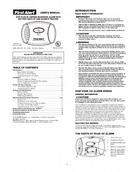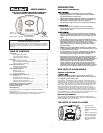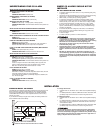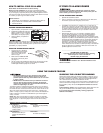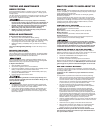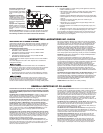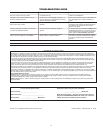
4
WHAT YOU NEED TO KNOW ABOUT CO
WHAT IS CO?
CO is an invisible, odorless, tasteless gas produced when fossil fuels do
not burn completely, or are exposed to heat (usually fire). Electrical appli-
ances typically do not produce CO.
These fuels include: Wood,coal, charcoal,oil, natural gas,gasoline,
kerosene,and propane.
Common appliances are often sources of CO.If they are not properly
maintained,are improperly ventilated, or malfunction, CO levels can rise
quickly. CO is a real danger now that homes are
more energy efficient.
“Air-tight” homes with added insulation, sealed windows, and other
weatherproofing can “trap” CO inside.
SYMPTOMS OF CO POISONING
These symptoms are related to CO POISONING and should be
discussed with ALL household members.
Mild Exposure:
Slight headache, nausea, vomiting,fatigue (“flu-like” symptoms).
Medium Exposure:
Throbbing headache, drowsiness, confusion, fast heart rate.
Extreme Exposure:
Convulsions,unconsciousness, heart and lung failure. Exposure to
carbon monoxide can cause brain damage, death.
Some individuals are more
sensitive to CO than others, including
people with cardiac or respiratory problems,infants, unborn babies,
pregnant mothers, or elderly people can be more quickly and
severely affected by CO. Members of sensitive populations should
consult their doctors for advice on taking additional precautions.
FINDING THE SOURCE OF CO AFTER AN ALARM
Carbon monoxide is an odorless, invisible gas, which often makes it
difficult to locate the source of CO after an alarm.These are a few of the
factors that can make it difficult to locate sources of CO:
• House well ventila
ted before the investigator arrives.
• Problem caused by “backdrafting.”
• Transient CO problem caused by special circumstances.
Because CO may dissipate by the time an investigator arrives, it may be
difficult to locate the source of CO. BRK Brands, Inc. shall not be obli-
gated to pay for any carbon monoxide investigation or service call.
HOW CAN I PROTECT MY FAMILY?
A CO Alarm is an excellent means of protection. It monitors the air and
sounds a loud alarm before carbon monoxide levels become threatening
for average, healthy adults.
A CO Alarm is not a substitute for proper maintenance of home
appliances.
To help prevent CO problems and reduce the risk of CO poisoning:
• Clean chimneys and flues yearly. Keep them free of debris, leaves,
and nests for proper air flow. Also, have a professional check for
rust and corrosion,cracks, or separations.These conditions can
prevent p
roper air movement and cause backdrafting. Never “cap”
or cover a chimney in any way that would block air flow.
• Test and maintain all fuel-burning equipment annually. Many
local gas or oil companies and HVAC companies offer appliance
inspections for a nominal fee.
• Make regular visual inspections of all fuel-burning appliances.
Check appliances for excessive rust and scaling.Also check the
flame on the burner and pilot lights.The flame should be blue.
A yellow flame means fuel is not being burned complete
ly and CO
may be present. Keep the blower door on the furnace closed. Use
vents or fans when they are available on all fuel-burning appliances.
Make sure appliances are vented to the outside. Do not grill or
barbecue indoors, or in garages or on screen porches.
• Check for exhaust backflow from CO sources. Check the draft hood
on an operating furnace for a backdraft. Look for cracks on furnace
heat exchangers.
• Check the house or garage on the other side of shared wall.
• Keep windows and doors open slightly. If you suspect
that CO is
escaping into your home, open a window or a door.Opening
windows and doors can significantly decrease CO levels.
In addition, familiarize yourself with all enclosed materials.Read
this manual in its entirety,and make sure you understand what to
do if your CO Alarm sounds.
TESTING AND MAINTENANCE
WEEKLY TESTING
Press the Test/Silence button on the Alarm cover until alarm sounds.
During testing, you will hear a loud alarm sequence – 4 beeps, pause,
4 beeps,pause.
The alarm sequence should last 5-6 seconds.If it does not alarm, make
sure the unit is fully plugged into an unswitched outlet. If the unit still
does not alarm, replace it immediately.
• If the Alarm ever fails to test properly,replace it immediately.
Products under warranty may be returned to the manufacturer for
replacement. See “Limited Warranty” at
the end of this manual.
• DO NOT stand close to the Alarm when the horn is sounding.
Exposure at close range may be harmful to your hearing.
When testing,step away when horn starts sounding.
• NEVER use vehicle exhaust! Exhaust may cause permanent
damage and voids your warranty.
REGULAR MAINTENANCE
To keep the CO Alarm working properly:
• Test it every week as described in “Weekly Testing.”
• Vacuum the CO Alarm cover at least once a month,using the soft
brush attachment. Never use water,cleaners, or solvents,since they
may damage the unit.Test the Alarm again af
ter vacuuming.
• Replace the battery immediately when you hear the “Low Battery
Warning”.
The Low (or Missing) Battery Warning: The horn will “chirp” once a
minute.
REPLACING THE BATTERY
Choosing a Replacement Battery:
This CO Alarm requires two standard AA batteries.The following batter-
ies are acceptable as replacements: Energizer E91.
These replacement
batteries are commonly available at local retail stores.
Use only the alkaline or lithium replacement batteries listed.The unit
may not operat
e properly with other batteries.Never use rechargeable
batteries since they may not provide a constant charge.
To Replace The Batteries:
1. Open the battery compartment.
2. Use the thumb guide to remove the old batteries.
3. Insert the new batteries, making sure they snap completely into the
battery compartment and cannot be shaken loose.
4. Close the battery compartment, then test the battery back-up by
pressing the Test/Silence button.
5. Plug the CO Alarm back into the outlet.
DO NO
T spray cleaning chemicals or insect sprays directly on or
near the CO Alarm. DO NOT paint over the CO Alarm. Doing so may
cause permanent damage.
• Household cleaners,aerosol chemicals and other contaminants
can affect the sensor.When using any of these materials near the
CO Alarm, make sure the room is well ventilated.
• If your home is being fumigated,unplug the unit temporarily and
put it where it will not be exposed to chemicals or fumes.When
fumigation is complete and all traces of fumes clear,plug the unit
back in and retest
it.













